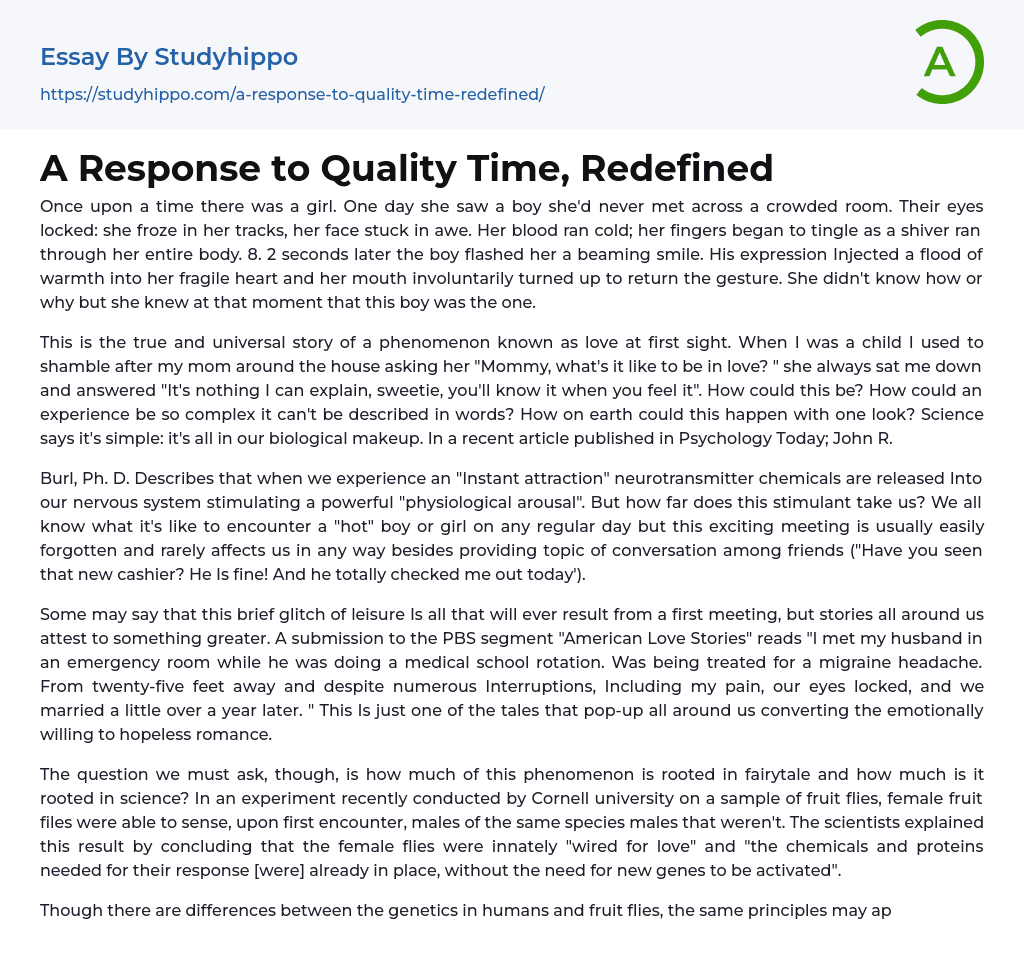In a crowded room, a girl and a boy met for the first time. Their eyes locked, causing her to freeze in amazement. She felt chills run down her spine and tingling sensations in her fingers. After 8.2 seconds, the boy smiled warmly at her, bringing warmth to her delicate heart. Unconsciously, she smiled back, realizing that this boy was meant for her.
This story represents love at first sight - an indescribable feeling according to my mother when I asked about it as a child. It's an emotion that can only be understood through personal experience. The complexity of this emotion and its power from just one glance is explained by science.
In an article published on Psychology Today by John R. Burl, Ph.D., he states that instant attraction triggers our nervous system to release neurotransmitter chemicals that create intense physiological arousal.
...The arousal we feel when encountering an attractive person may seem insignificant in everyday life but stories of meeting one's spouse in unexpected places give hope for true love. However, we must consider if this phenomenon is based on fairytales or science itself.
An experiment conducted by Cornell University on fruit flies offers some insight into this matter.Female fruit flies have the ability to detect and differentiate males of their species from their first encounter even in the absence of genetic variations.
Scientists propose that these flies possess the necessary chemicals and proteins for love, implying that biological elements may influence our own experiences of romance. Despite the complexity of human thoughts and emotions, many individuals rely on something intangible and incomprehensible. Psychology Today's article "Love at First Sight" reveals that over
50% of Americans claim to have experienced love at first sight, influencing around 60% who believe in it. Regardless of one's belief, scientific evidence supports humans being capable of experiencing this phenomenon. Our society is saturated with notions of true love and fairytales that may seem unattainable due to their exaggerated portrayal of relationships. So what exactly is love? Is it a romantic duet under the starry sky or a brave prince rescuing a damsel from a fire-breathing dragon? Love, an enigmatic concept that has long puzzled humanity, has recently been explored scientifically thanks to technological advancements. In her article "The Science of Love" published in Parade, Judith Newman delves into the topic by discussing three specific brain chemicals that play distinct roles in understanding love.According to Newman, dopamine is the initial chemical associated with pleasurable and addictive sensations felt in love. In addition, the second neurotransmitter, called innerspring, generates jittery and nervous emotions commonly linked to being in love. Conversely, serotonin counters the effects of innerspring by releasing a calming substance in the brain. These three transmitters work together to create a combination of feelings that contribute to the experience of love. As scientists continue exploring human behavior complexities, they are uncovering more about our biological tendency to seek lifelong partners. It is possible that certain brain chemicals being released can trigger immediate feelings of love upon first sight. This suggests that our intelligence enables rapid reactions. While it would be unreasonable to claim that love is solely a mental construct or scientifically dismiss it as such would also be equally absurd. Love often reveals itself unexpectedly and manifests in various ways. There are
certain aspects of life that science cannot fully comprehend; even something as simple as a genuine smile holds deep significance.
- Action Potential essays
- Blood essays
- Body essays
- Brain essays
- Childbirth essays
- Eye essays
- Glucose essays
- Heart essays
- Human Physiology essays
- Immune System essays
- Kidney essays
- Muscle essays
- Nervous System essays
- Neuron essays
- Poison essays
- Puberty essays
- Sense essays
- Skeleton essays
- Skin essays
- Bacteria essays
- Biotechnology essays
- Breeding essays
- Cell essays
- Cell Membrane essays
- Cystic Fibrosis essays
- Enzyme essays
- Human essays
- Microbiology essays
- Natural Selection essays
- Photosynthesis essays
- Plant essays
- Protein essays
- Stem Cell essays
- Viruses essays
- Adoption essays
- Aunt essays
- Babies essays
- Bedroom essays
- Caring essays
- Children essays
- Daughter essays
- Divorce essays
- Dog essays
- Dysfunctional Family essays
- Family Tradition essays
- Family Values essays
- Father essays
- Foster Care essays
- Friends essays
- Grandparent essays




